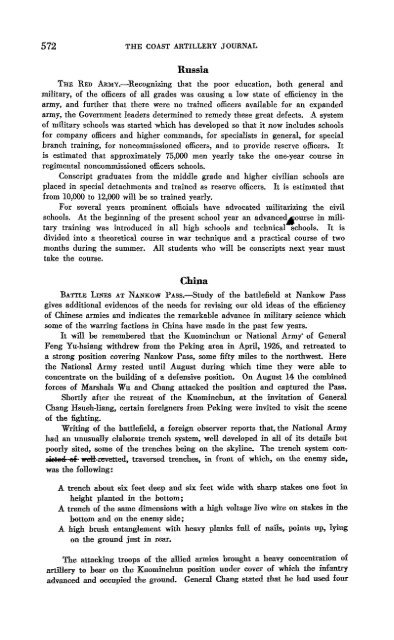COAST ARTILLERY, JOURNAL - Air Defense Artillery
COAST ARTILLERY, JOURNAL - Air Defense Artillery
COAST ARTILLERY, JOURNAL - Air Defense Artillery
Create successful ePaper yourself
Turn your PDF publications into a flip-book with our unique Google optimized e-Paper software.
572 THE <strong>COAST</strong> <strong>ARTILLERY</strong> <strong>JOURNAL</strong><br />
Russia<br />
THE RED ARMv.-Recognizing that the poor education, both general and<br />
military, of the officersof all grades was causing a low state of efficiencyin the<br />
army, and further that there were no trained officers available for an expanded<br />
army, the Governmentleaders determined to remedy these great defects. A system<br />
of military schoolswas started which has developedso that it now includes schools<br />
for company officers and higher commands, for specialists in general, for special<br />
branch training, for noncommissionedofficers,and to provide reserve officers. It<br />
is estimated that approximately 75,000 men yearly take the one-year course in<br />
regimental noncommissionedofficersschools.<br />
Conscript graduates from the middle grade and higher civilian schools are<br />
placed in special detachments and trained as reserve officers. It is estimated that<br />
from 10,000to 12,000will be so trained yearly.<br />
For several years prominent officials have advocated militarizing the civil<br />
schools. At the beginning of the present school year an advanced.. ourse in military<br />
training was introduced in all high schools and technical schools. It is<br />
divided into a theoretical course in war technique and a practical course of two<br />
months during the summer. All students who will be conscripts next year must<br />
take the course.<br />
China<br />
BA'ITLELINESAT NANKOWPAss.-Study of the battlefield at Nankow Pass<br />
gives additional evidences of the needs for revising our old ideas of the efficiency<br />
of Chinese armies and indicates the remarkable advance in military science which<br />
some of the warring factions in China have made in the past few years.<br />
It will be remembered that the Kuominchun or National Army' of General<br />
Feng Yu-hsiang withdrew from the Peking area in April, 1926, and retreated to<br />
a strong position covering Nankow Pass, some fifty miles to the northwest. Here<br />
the National Army rested until August during which time they were able to<br />
concentrate on the building of a defensive position. On August 14 the combined<br />
forces of Marshals Wu and Chang attacked the position and captured the Pass.<br />
Shortly after the retreat of the Kuominchun, at the invitation of General<br />
Chang Hsueh-liang, certain foreigners from Peking were invited to visit the scene<br />
of the fighting.<br />
Writing of the battlefield, a foreign observer reports that. the National Army<br />
had an unusually elaborate trench system, well developed in all of its details but<br />
poorly sited, some of the trenches being on the skyline. The trench system con-<br />
~I'l M- weH-revett:ed,traversed trenches, in front of which, on the enemy side,<br />
was the following:<br />
A trench about six feet deep and six feet wide with sharp stakes one foot in<br />
height planted in the bottom;<br />
A trench of the same dimensions with a high voltage live wire on stakes in the<br />
bottom and on the enemy side;<br />
A high brush entanglement ...ith heavy planks full of nails, points up, lying<br />
on the ground just in rear.<br />
The attacking troops of the allied armies brought a heavy concentration of<br />
artillery to bear on the Kuominchun position under cover of which the infantry<br />
advanced and occupied the ground. General Chang stated that he had used four
















